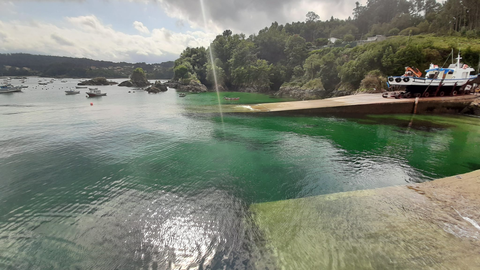
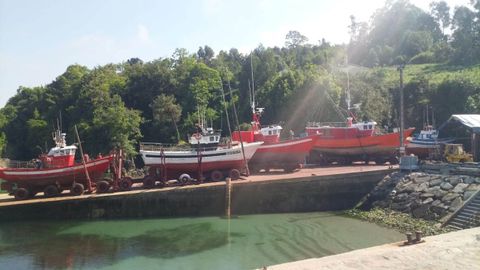
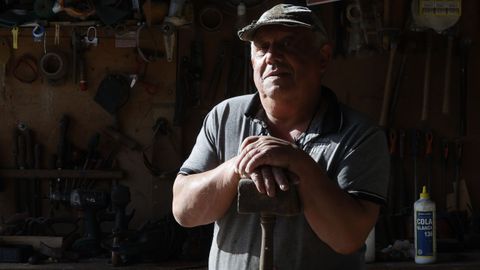

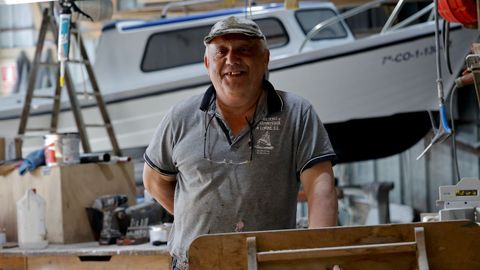
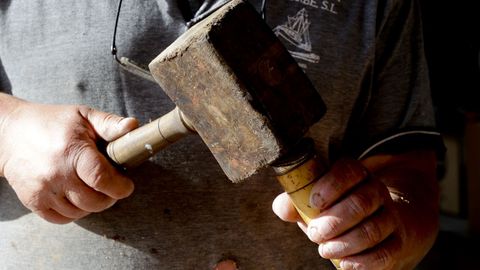
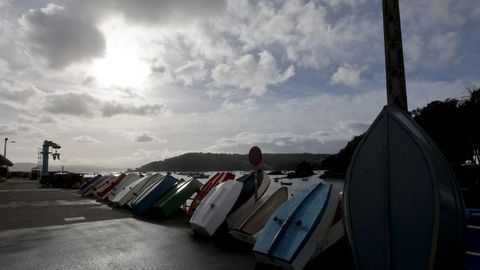



Pepe Gómez has been building wooden boats for five decades. He is at the helm of one of the 13 shipwrighting businesses in Galicia that refuse to yield and continue to practise this ancient craft in the 21st century. His company in Lorbé, within the municipality of Oleiros, has its future assured with his son at the helm
02 jun 2023 . Actualizado a las 19:24 h.The April sun sparkles atop the emerald waters of the small port of Lorbé, which is quietly beautiful. Small colourful wooden boats known as chalanas, black cormorants, mussel rafts, skittish cats and a strong smell of the sea all invite you to tarry a while as you watch the clouds give way to the blue skies of spring. It is now eleven o’clock in the morning and the dockside is a bustle of activity: bateeiros (mussel seed collectors), redeiras (fishing net makers) and fishermen work busily in the dock and the pontoons. A bright red ship at the foot of the ramp hides —perhaps unwittingly— a treasure of the cultural and maritime heritage of our country: Pepe Gómez’s shipwrighting business, one of only 13 still up and running in Galicia in the 21st century.
Pepe’s full name is José Manuel Gómez Porto (born Veigue, Sada, in 1959) and he has been building wooden boats for half a century. “I learned the trade at the shipyard in Sada, alongside Emilio Babío. I started out as an apprentice at the age of 14 and we made seven boats together, the largest of which was 23 metres long,” recalls Pepe, who is now close to retiring but has the peace of mind of leaving his dry dock in the capable hands of his son. “José Francisco is already in charge. He’s now the one who pays the bills and places the orders. My son is even better at his job than me, because he is more discerning and detail-oriented. He’s also more agile and quicker at getting things done. I’ve done my bit... I have nothing left to prove,” he proudly proclaims.

After spending 30 years in Sada, where they worked with fibreglass rather than wood, he worked for a year and a half in the shipyard of A Coruña, but with his sights already firmly set on the port of Lorbé. “There was nothing here before, just the dry dock slipway, which was in a sorry state. Since then we managed to get the authorities to extend the ramp because the waterline was too low. I’ve been here for 20 years and during that time we’ve built six wooden boats, the largest being an 11-meter fishing vessel for Pontedeume,” he explains, as he inspects the hull of a huge boat he is repairing this morning.
Craftsmanship that sails with the wind
Three Pepes work at this shipwrighting business, which receives orders from beyond the River Eo. José Manuel, José Francisco and José Antonio —the father, the son and an employee— are not short for work. “I’m here every day from nine until seven and you’ll often find me working on public holidays. In January we spent just over a week in Ondarroa, over 400 miles away, to repair a 24-meter fishing boat that had careened into the breakwater and lost its entire bow. And we’re about to receive a 14-meter boat from Lastres, Asturias, to undergo some repairs. The owner told me that there are no shipwrights to be found over there in Avilés”, explains Pepe, who also has many customers from Malpica in Galicia.

It’s been a wonderful journey, with the odd bad day here and there. That is how he sums up these last 50 years of work. “There’s something beautiful about building a wooden boat; first you put the keel on and then you add the ribs. I really enjoy working with wood, as polyester is toxic. You have to do what you enjoy; if you don’t, you’ll get stuck in a rut. It’s also a complicated and laborious job, and you have to be skilled,” remarks Pepe, who often feels that his work goes unrecognised. “If you can’t make a living off it, it’s no good being a craftsman. It’s only worth it if it puts food on the table. The best thing about repairing a boat is getting paid when you’re done,” jokes the nearly 64-year-old, who built his last boat in November.
While most of Pepe’s boats are meant for sailing, there are also some on display in museums. The Naval Museum of Ferrol houses three replicas that he made, during the time he did his military service between 1979 and 1980. “I built the hull of the frigate Magdalena, which measures three meters and is made of mahogany; as well as a small galleon; and a xeiteira boat for sardine fishing. Other craftsmen made the frames, the figurehead and the masts,” recalls Pepe, who also repaired the ship-museum docked in the Port of Burela.

The son of a sailor, he confesses that he often looks out towards the fishing port of Lorbé, even though it now stands abandoned, he laments. “I think working here is great, plus it’s where I grew up because, while I was born in Veigue, when I was eight years old we moved to Lorbé,” recalls this fishing lover, who is none too keen about the prospect of retiring. “I don’t know when I’ll retire. For now, I plan to keep going. I’m certainly not going to stay cooped up at home. That would be the end of my marriage. You’ll find me here working on one or other of my little projects,” he says, before reaching for a photograph of a wooden rocking horse that he built for one of his grandchildren.
As one of the last practitioners of a dying craft, he condemns the lack of formal training in this discipline and the disinterest shown by the local government. “Councillor Rosa Quintana told me that she was very supportive of the shipwrighting industry, yet they don’t have wooden patrol boats,” bemoans Pepe, who has a firm favourite from among all the boats he has built throughout his life. “It’s the Ribera, measuring 18 meters. It had something special. While out on the seas, it would climb the waves majestically. It’s since been scrapped,” he says, looking out sadly over the Ares and Betanzos estuaries as if he were watching it happen.